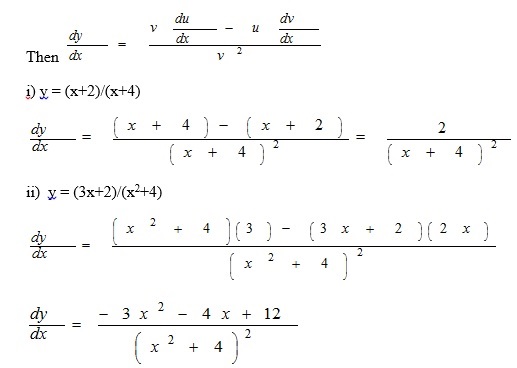Differentiation Assignment Help

Differentiation Introduction
Differentiation is all about finding rates of change of one quantity compared to another. We need differentiation when the rate of change is not constant. The slope of a curve at a point tells us the rate of change of the quantity at that point. The process of finding a derivative is called differentiation.
Rules for Differentiation
The Constant Rule
If y = c where c is a constant,
dy/dx = 0
e.g. y = 10 then
dy/dx = 0
dy/dx = 0
The Linear Function Rule
If y = a + bx
dy/dx = b
e.g. y = 10 + 6x then
dy/dx = 6
The Power Function Rule
If y = axn, a & n are constants
dy/dx = n . a . xn-1
i) y = 4x =>
dy/dx = 4 x 0 = 4
ii) y = 4x2 =>
dy/dx = 8 x
iii) y = 4x3 =>
dy/dx = 12 x2
iv) y = 4x-2 =>
dy/dx = - 8 x - 3
The Sum-Difference Rule
If y = f(x) ± g(x)
Differentiation Assignment Help By Online Tutoring and Guide Sessions at AssignmentHelp.Net

If y is the sum/difference of two or more functions of x: differentiate the 2 (or more) terms separately, then add/subtract.
(i) y = 2x2 + 3x then
dy/dx = 4 x + 3
(ii) y = 4x2 - x3 - 4x then
dy/dx = 8 x - 3 x 2 - 4
(iii) y = 5x + 4 then
dy/dx = 5
The Product Rule
If y = u.v where u and v are functions of x Then

i) y = (x+2)(ax2+bx)
dy/dx = (x + 2)(2 ax + b)+(ax 2 + bx)
ii) y = (4x3-3x+2)(2x2+4x)
dy/dx = (4 x 3 - 3x +2)(2x2 + 4x)
dy/dx =(4x3 - 3 x + 2)(4 x + 4) + (2 x 2 + 4 x)(12 x2 - 3)
The Quotient Rule
If y = u/v where u and v are functions of x

The Chain Rule
If y is a function of v, and v is a function of x, then y is a function of x and
dy/dx = dy/dv . dv/dx
i) y = (ax2 + bx)
let v = (ax2 + bx), so y = v
dy/dx = 1/2 (ax 2 + bx )-1/2 . (2 ax + b)
ii) y = (4x3 + 3x 7 )4
let v = (4x3 + 3x 7 ), so y = v4
dy/dx = 4(4x3 + 3x - 7)3 . (12 x2 + 3)
The Inverse Function Rule
If x = f(y) then dy/dx = 1/ dx/dy
The derivative of the inverse of the function x = f(y), is the inverse of the derivative of the function
(i) x = 3y2 then
dy/dx = 6 y so dy/dx = 1/6y
(ii) y = 4x3 then
dy/dx = 12 x2 so dx/dy = 1/12 x2
Rule 9: Differentiating Natural Logs
if y = loge x = ln x =>
dy/dx = 1/x
NOTE: the derivative of a natural log function does not depend on the co-efficient of x
Thus, if y = ln mx => dy/dx = 1/x
Proof
if y = ln mx m>0
Rules of Logs => y = ln m+ ln x
Differentiating (Sum-Difference rule)
dy/dx= 0 + 1/x = 1/x
Example:
Find the equation of the normal to the curve y = 3 x - x at the point where x = 4.
Solution:
The curve can be written as y = 3x1/2 - x
Therefore, dy/dx = 3/2 x-1/2 - 1
When x = 4, y = 34 - 4 = 2
and dy/dx = 3/2*4-1/2 -1 = 3/2*1/2*-1 = -1/4
So the gradient of the normal is m = -1/ -1/4 = 4 .
To find the equation of the tangent:
y = mx + c => y = 4x + c
Substitute x = 4, y = 2: 2 = 4(4) + c i.e. c = -14.
So equation is y = 4x 14.
Important functions for differentiation:
Exponential and logarithmic functions:
d/dx ex = ex.
d/dx ax = In(a)ax.
d/dx In(x) = 1/x, x >0.
d/dx loga(x) = 1/x In(a).
Trigonometric functions:
d/dx sin(x) = cos(x).
d/dx cos(x) = -sin(x).
d/dx tan(x) = sec2 = 1/cos2(x) = 1 + tan2(x).
Inverse trigonometric functions:
d/dx arcsin(x) = 1/1-x2, -1 < x < 1.
d/dx arccos(x) = - 1/1-x2, -1 < x < 1.
d/dx arctan(x) = 1/1 + x2


